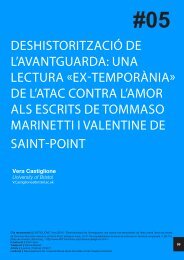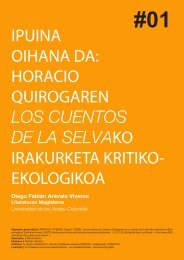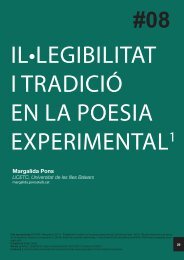03 - 452ºF
03 - 452ºF
03 - 452ºF
You also want an ePaper? Increase the reach of your titles
YUMPU automatically turns print PDFs into web optimized ePapers that Google loves.
If a work of art can picture the scene of postmodern America in the<br />
eighties, with the impact of technological mediations and the role<br />
of the shopping center in the emergence of consumer culture, it is<br />
undoubtedly Don DeLillo’s White Noise. This novel can simply be<br />
described as a postmodern critique of contemporary American life. It<br />
is no wonder that this novel won the National Book Award immediately<br />
after its publication in 1985, and it also marked the increase of<br />
DeLillo’s fame and readership. The novel skillfully tackles the major<br />
aspects of postmodern life; it depicts the electronic and technological<br />
effects on the meaning of everyday life in the postmodern age. It also<br />
sheds light on TV as an essential icon of this era. People are shown<br />
to be living their lives, behaving, believing and disbelieving according<br />
to TV. The supermarket–or the hypermarket–is also shown as a new<br />
place that controls people’s lives and gives them a new meaning in<br />
the post-industrial, consumer culture.<br />
To begin with, TV, as shown in the novel, is one of the most influential<br />
technological devices in contemporary life. It plays a tremendous role<br />
in the life of individuals, to the extent that it has changed the criteria<br />
of reality and truth. TV has become the new reality–or more real than<br />
reality itself. In White Noise, TV is as important and influential as the<br />
protagonist of the novel, Jack Gladney. It fills the world of the novel<br />
with its buzzes and fragments and it pops up every now and then to<br />
interrupt the actions of the novel. TV seems to control all people; they<br />
believe nothing but TV. As Leonard Wilcox in his essay, «Baudrillard,<br />
DeLillo’s White Noise and the end of Heroic Narrative», puts it, «White<br />
Noise is bathed in the eerie glow of television» (Wilcox, 20<strong>03</strong>: 355).<br />
Murray Siskind, Jack’s friend and colleague at College-on-the Hill, a<br />
lecturer on living icons, is one of the characters who embraces TV as<br />
the new source of knowledge and a generator of contemporary life,<br />
he describes his experience:<br />
You have to learn how to look. You have to open yourself to the data.<br />
TV offers incredible amounts of psychic data. It opens ancient memories<br />
of world birth. It welcomes us into the grid, the network of little buzzing<br />
dots that make up the picture pattern. There is light, there is sound...look<br />
at the wealth of data concealed in the grid, in the bright packaging, the<br />
jingles…the medium practically overflows with sacred formulas if we can<br />
remember how to respond innocently. (DeLillo, 1985: 51)<br />
Murray’s description of this experience shows how the hyperreality of<br />
TV, generated by «the network of little buzzing dots,» though unreal,<br />
is considered something more real than the real, and how the viewers<br />
have to surrender all their senses to this source of information. But<br />
why do the masses have to succumb? And where is the role of the<br />
recipient in this process?<br />
Responding «innocently» or passively, according to French theorist<br />
Jean Baudrillard is a kind of receiving information and rejecting<br />
Living in a simulacrum: how TV and the supermarket redefines reality in Don DeLillo’s White noise - Ahmad Ghashmari<br />
<strong>452ºF</strong>. #<strong>03</strong> (2010) 172-186.<br />
173










